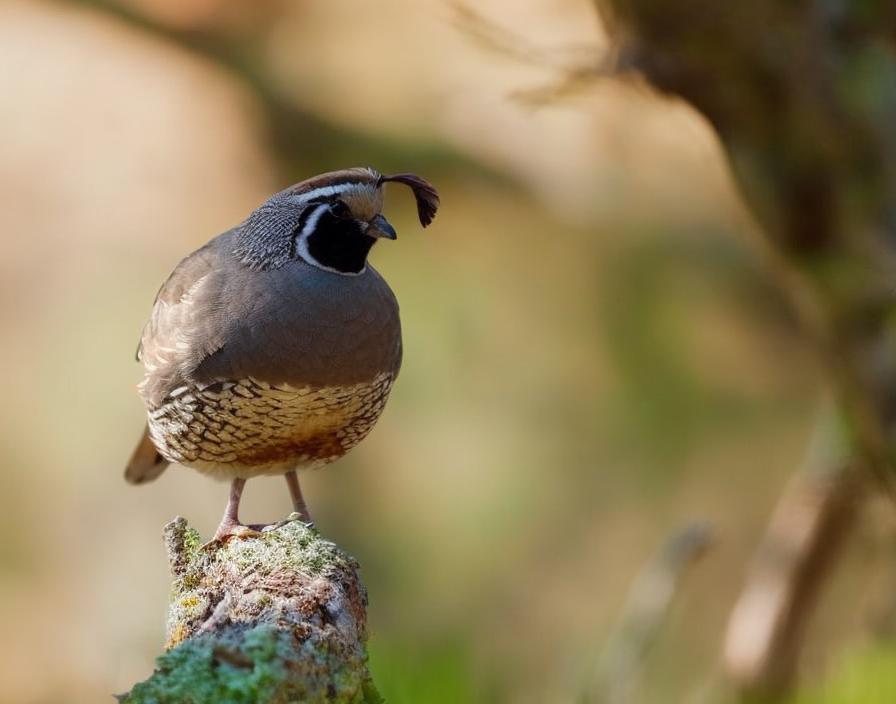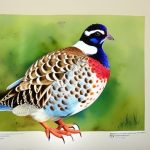Quails are small, ground-dwelling birds that belong to the pheasant family. There are several different quail breeds, each with its own unique characteristics and traits. Some of the most popular quail breeds include the Coturnix quail, Bobwhite quail, Gambel’s quail, and California quail. Each breed varies in size, coloration, and behavior, making them an interesting and diverse group of birds to keep.
Coturnix quail, also known as Japanese quail, are one of the most commonly raised quail breeds for their high egg production and fast growth rate. They come in a variety of colors, including brown, white, and tuxedo. Bobwhite quail are native to North America and are known for their distinctive call and attractive plumage. Gambel’s quail are found in the southwestern United States and are known for their striking black and white facial markings. California quail, also known as Valley quail, are known for their sociable nature and distinctive topknot plume on their heads. Understanding the characteristics and behaviors of each quail breed is essential for successfully keeping them together in a mixed flock.
Key Takeaways
- There are various quail breeds with different characteristics and requirements for housing and social dynamics.
- Quail are social birds that have a complex hierarchy and communication system within their groups.
- Factors such as breed compatibility, space, and resources should be considered when housing different quail breeds together.
- Introducing quail breeds to each other gradually and providing plenty of space and resources can help minimize aggression and stress.
- Regular monitoring of quail interactions and providing solutions for potential challenges can help maintain a harmonious environment for different quail breeds.
Understanding Quail Behavior and Social Dynamics
Quails are social birds that thrive in the company of their own kind. They have a complex social structure and communicate through a variety of vocalizations and body language. Understanding quail behavior and social dynamics is crucial for successfully keeping different quail breeds together in a mixed flock.
Each quail breed has its own unique social dynamics and hierarchy within the flock. For example, Coturnix quail are known for their relatively peaceful nature and can be kept in large groups without much aggression. On the other hand, Bobwhite quail are more territorial and may exhibit aggressive behavior, especially during breeding season. Understanding these differences in behavior is important when housing different quail breeds together to prevent conflicts and ensure the well-being of the birds.
Quails also have specific behaviors related to feeding, mating, and nesting. Observing these behaviors can provide valuable insights into the social dynamics of the flock and help identify any potential issues or conflicts. By understanding the natural behaviors of each quail breed, you can create a harmonious environment for them to live together peacefully.
Factors to Consider When Housing Different Quail Breeds Together
When housing different quail breeds together, there are several factors to consider to ensure the well-being and harmony of the flock. One important factor is the size of the enclosure. Quails require ample space to move around and establish their territories. Providing enough space for each breed to establish their own territories can help minimize aggression and conflicts within the flock.
Another factor to consider is the ratio of males to females within the flock. In general, it’s best to have a higher ratio of females to males to prevent excessive mating aggression and ensure a more balanced social dynamic. Additionally, providing multiple feeding and watering stations can help prevent competition for resources and reduce stress within the flock.
It’s also important to consider the compatibility of different quail breeds based on their behavior and temperament. Some breeds may be more aggressive or territorial than others, which can lead to conflicts when housed together. Understanding the specific traits and behaviors of each breed is essential for creating a harmonious living environment for mixed quail flocks.
Tips for Introducing Different Quail Breeds to Each Other
Introducing different quail breeds to each other requires careful planning and consideration to minimize stress and potential conflicts. One effective way to introduce new quail breeds is by using a gradual introduction method. This involves placing the new birds in a separate enclosure within sight of the existing flock for a period of time to allow them to become familiar with each other’s presence without direct contact.
Another tip for introducing different quail breeds is to provide multiple hiding spots and visual barriers within the enclosure. This can help reduce aggression and provide a sense of security for the birds as they adjust to their new environment. Additionally, providing plenty of food and water stations can help prevent competition for resources during the introduction process.
It’s also important to monitor the behavior of the birds closely during the introduction period. Look for signs of aggression, such as pecking or chasing, and be prepared to separate birds if necessary to prevent injuries. By taking a gradual and cautious approach to introducing different quail breeds, you can help minimize stress and ensure a smooth transition for all birds involved.
Monitoring and Managing Quail Interactions
Once different quail breeds have been introduced to each other, it’s important to monitor their interactions closely to ensure a harmonious living environment. Regular observation of the flock can help identify any potential conflicts or issues that may arise as the birds establish their social hierarchy.
One way to monitor quail interactions is by observing their behavior during feeding time. Aggressive behavior around food stations can be a sign of competition and potential conflicts within the flock. Providing multiple feeding stations can help reduce competition and minimize stress during feeding time.
Another important aspect of managing quail interactions is providing adequate space and enrichment within the enclosure. Quails require space to establish their territories and engage in natural behaviors such as dust bathing and foraging. Providing plenty of hiding spots, perches, and enrichment activities can help reduce stress and provide outlets for natural behaviors within the flock.
Regularly observing the flock’s behavior and interactions can provide valuable insights into their social dynamics and help identify any potential issues before they escalate. By actively managing quail interactions, you can create a peaceful and harmonious living environment for different quail breeds.
Potential Challenges and Solutions for Keeping Different Quail Breeds Together

Keeping different quail breeds together in a mixed flock can present several challenges, including aggression, mating conflicts, and territorial disputes. One potential challenge is aggression between different quail breeds, especially during the introduction period or when establishing a new social hierarchy within the flock. Providing ample space, multiple hiding spots, and visual barriers can help reduce aggression and provide a sense of security for all birds involved.
Mating conflicts can also arise when housing different quail breeds together, particularly if there is an imbalance in the male-to-female ratio within the flock. To prevent excessive mating aggression, it’s important to maintain a higher ratio of females to males and provide plenty of hiding spots for females to escape unwanted attention from males.
Territorial disputes may occur as different quail breeds establish their territories within the enclosure. Providing enough space for each breed to establish their own territories can help minimize territorial conflicts and reduce stress within the flock. Additionally, providing ample enrichment activities such as perches, dust bathing areas, and foraging opportunities can help redirect aggressive behaviors and provide outlets for natural behaviors.
By understanding these potential challenges and implementing proactive solutions, you can create a harmonious living environment for different quail breeds in a mixed flock.
Conclusion and Best Practices for Keeping Different Quail Breeds Together
In conclusion, keeping different quail breeds together in a mixed flock requires careful consideration of their behavior, social dynamics, and environmental needs. By understanding the unique characteristics of each quail breed and implementing best practices for housing and managing interactions, you can create a harmonious living environment for all birds involved.
Some best practices for keeping different quail breeds together include providing ample space, multiple hiding spots, visual barriers, and enrichment activities within the enclosure. It’s also important to maintain a balanced male-to-female ratio within the flock to prevent mating conflicts and excessive aggression.
Regular monitoring of quail interactions and behavior can provide valuable insights into their social dynamics and help identify any potential issues before they escalate. By actively managing quail interactions and addressing any conflicts or challenges that arise, you can create a peaceful and harmonious living environment for different quail breeds in a mixed flock.
Overall, with careful planning, observation, and proactive management, it is possible to successfully keep different quail breeds together in a mixed flock while ensuring the well-being and harmony of all birds involved.
If you’re considering keeping different breeds of quail together, it’s important to understand their compatibility and living requirements. Just like with chickens, the size and layout of the coop play a crucial role in maintaining harmony among different quail breeds. To learn more about creating an ideal living space for your quail, check out this insightful article on poultrywizard.com. Understanding the dynamics of coop size and design can help ensure a peaceful and thriving environment for your quail flock.
FAQs
Can different breeds of quail live together?
Yes, different breeds of quail can live together as long as they are introduced to each other at a young age and have enough space to establish their own territories.
What should I consider before housing different breeds of quail together?
Before housing different breeds of quail together, it’s important to consider the size of the enclosure, the ratio of males to females, and the compatibility of the breeds in terms of temperament and size.
What are the potential challenges of housing different breeds of quail together?
Potential challenges of housing different breeds of quail together include aggression between different breeds, potential for hybridization, and the need to provide adequate space and resources for each breed.
How can I introduce different breeds of quail to each other?
To introduce different breeds of quail to each other, it’s best to do so when they are young and to provide plenty of space and hiding spots to reduce aggression. It’s also important to monitor their interactions closely during the introduction process.
What are some compatible breeds of quail that can live together?
Some compatible breeds of quail that can live together include Coturnix quail, Bobwhite quail, and Button quail. It’s important to research the specific breeds and their compatibility before housing them together.
Meet Walter, the feathered-friend fanatic of Florida! Nestled in the sunshine state, Walter struts through life with his feathered companions, clucking his way to happiness. With a coop that’s fancier than a five-star hotel, he’s the Don Juan of the chicken world. When he’s not teaching his hens to do the cha-cha, you’ll find him in a heated debate with his prized rooster, Sir Clucks-a-Lot. Walter’s poultry passion is no yolk; he’s the sunny-side-up guy you never knew you needed in your flock of friends!







